American Gilded Age
After the Civil War, fast-growing industries such as railroads, gunpowder and steel presented tremendous opportunity for wealth in Delaware and the Mid-Atlantic. Families of American industrialists (largely white) patterned themselves on European aristocracy in education, architecture and art collecting. They filled Beaux-Arts mansions with European and American art, and their cities with elite public institutions, including museums, libraries, opera houses and theaters. Some of America’s wealthy families established the Metropolitan Museum of Art in New York in 1870 and the Philadelphia Museum of Art in 1877. This age also introduced art schools, such as the Pennsylvania Academy of the Fine Arts, where students studied classical art techniques, and often traveled to France, Italy, Germany, Netherlands and Spain to begin careers under acknowledged masters. These artists returned to the United States with a wider variety of artistic points of view.
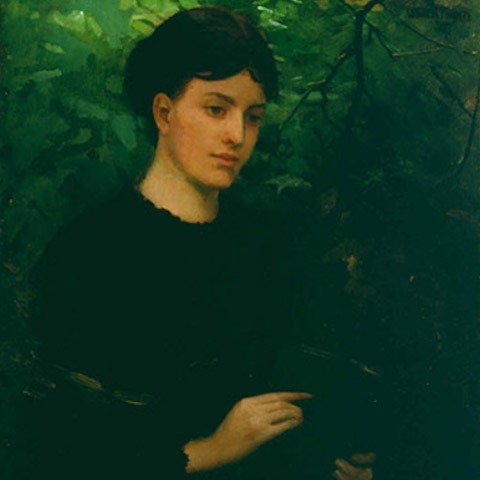
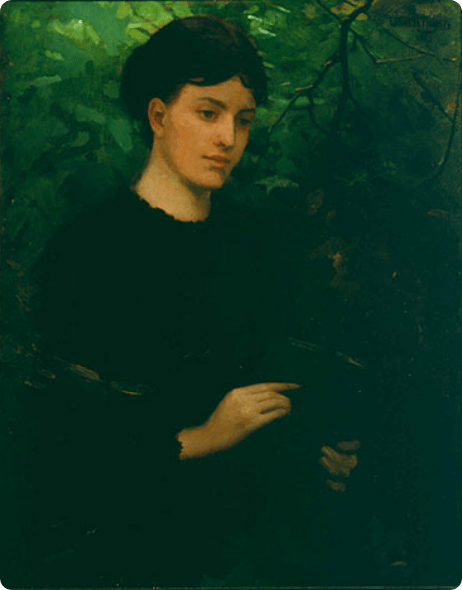
Boston-born Abbott Handerson Thayer began his art studies at the Brooklyn Art School and the National Academy of Design before spending four years at the École des Beaux-Arts in Paris. Thayer achieved recognition for his dramatic landscapes and romantic figures. The portrait here is of his second wife, Emma Beach Thayer (1849–1924), an artist in her own right who was known for her botanical paintings. Abbott Handerson Thayer was fascinated by camouflage (the ability for animals to blend into their surroundings), and it became a preoccupation for him in his artistic career. In this work, Thayer displays an early form of this interest by depicting Emmeline merging with the shadows and branches of the forest. The dark tones almost obscure the sketchbook she is holding, which marks her as an artist.
EMMELINE BEACH
ABBOTT HANDERSON THAYER (1849–1921)
1881
OIL ON CANVAS
GIFT OF SEWELL C. BIGGS; 1992.47
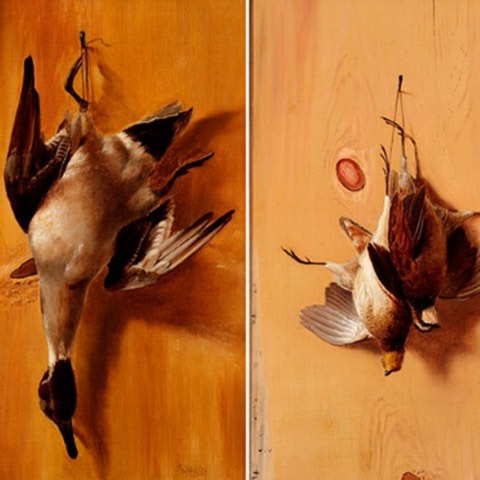
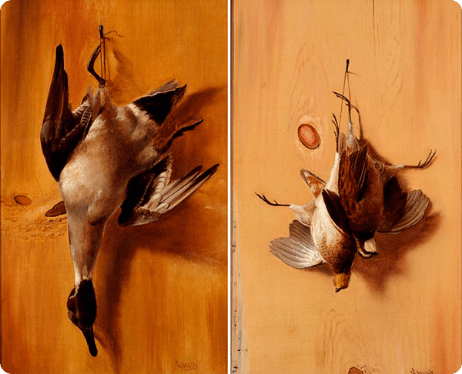
Upon his 1866 discharge from the U.S. Navy, Alexander Charles Stuart became a boat portraitist to the various shipbuilding companies along the Delaware River. Wilmington landscape artist, collector, and philanthropist Henry Lea Tatnall (1829–1885) befriended Stuart, and Stuart met many accomplished painters as a result. One of Tatnall’s friends, William Michael Harnett (1848–1892), may have introduced Stuart to trompe l’oeil painting like this, in which the subject seems to exist in three dimensions.
GAME STILL LIFES
ALEXANDER CHARLES STUART (1831–1898)
CA. 1880–95
OIL ON CANVAS
GIFT OF SEWELL C. BIGGS; 1996.20.1–.2
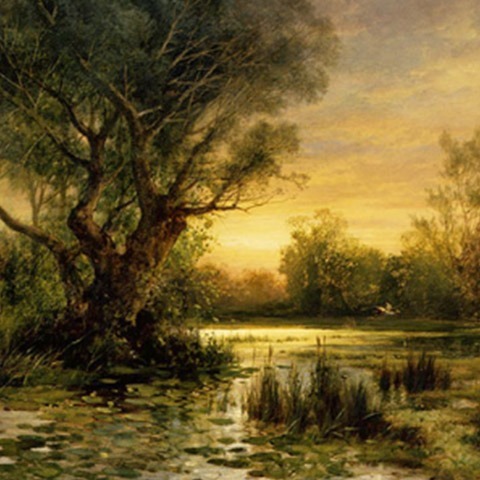
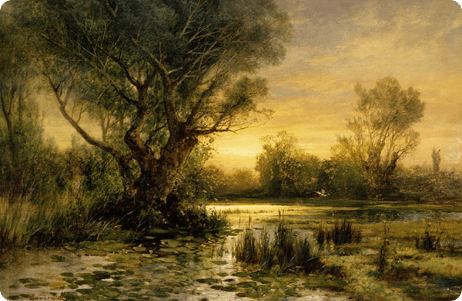
Born in England, Edward Moran immigrated to America with his family in the 1840s. By 1866, he had returned to England as a student at the Royal Academy of London, and later painted in Paris. His brother Thomas Moran (1837–1926) was an equally important artist who remained in America to join the Hudson River School and paint images of the American West. Edward, on the other hand, focused on dramatically lit and epic marine subjects.
MARSH LANDSCAPE
EDWARD MORAN (1829–1901)
CA. 1885–90 OR SLIGHTLY LATER
WATERCOLOR ON PAPER
GIFT OF SEWELL C. BIGGS; 1992.30
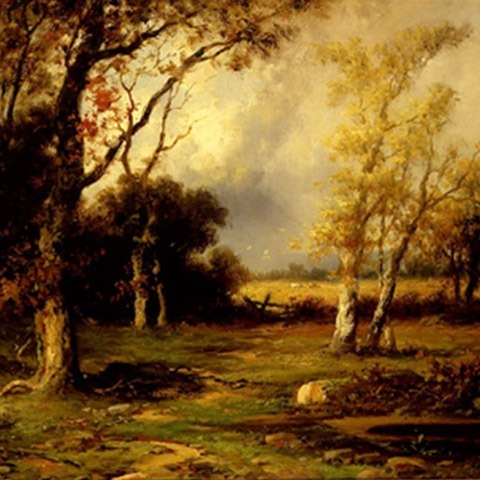
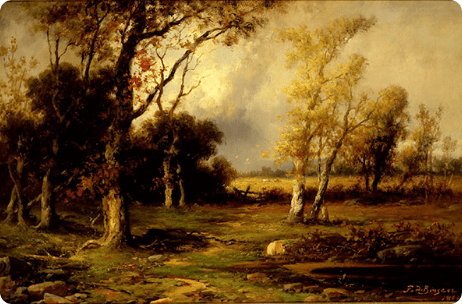
Known principally as a marine artist and student of Edward Moran (1829–1901), Franklin Briscoe also studied in England and France. While there, he would have been aware of the work of plein-air artists who were associated with the Barbizon movement, which implemented the technique of painting outdoors, from life, and profoundly influenced his later landscapes.
AUTUMN LANDSCAPE
FRANKLIN DULLIN BRISCOE (1844–1903)
1894
OIL ON CARDBOARD
GIFT OF SEWELL C. BIGGS; 1992.4
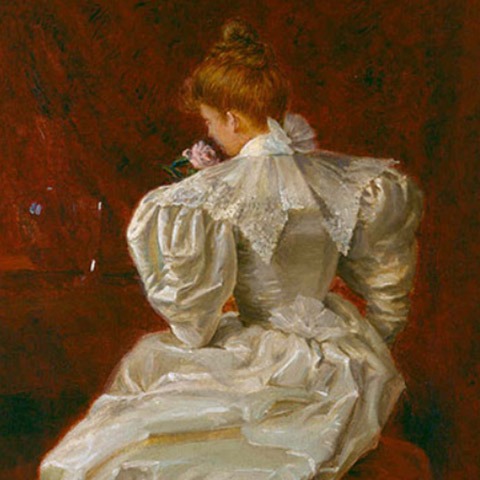
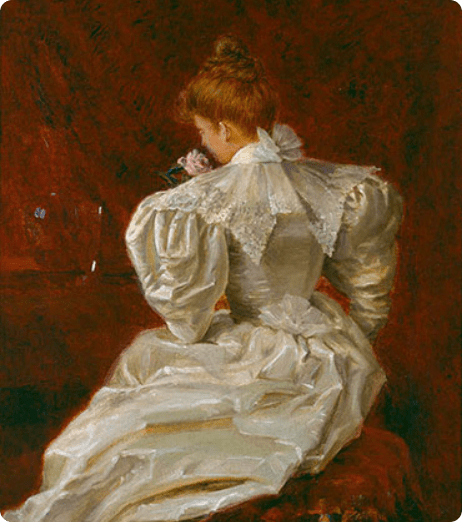
Born in Wilmington, Delaware, Clawson Shakespeare Hammitt received his early art education and support from Methodist minister Alfred Thompson Scott (1832–1914) and artist and collector Henry Lea Tatnall (1829–1885). In 1882, Hammitt opened the first art school in Delaware, while continuing his own education, studying under Thomas Eakins (1844–1916), Thomas Anshutz (1851–1912), and William Merritt Chase (1849–1916), as well as the Académie Julian in Paris.
STUDY IN WHITE
CLAWSON SHAKESPEARE HAMMITT (1857–1927)
CA. 1890S
OIL ON CANVAS
GIFT OF SEWELL C. BIGGS; 1993.6
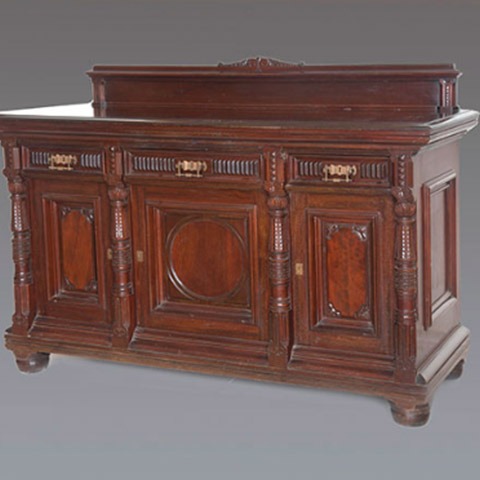
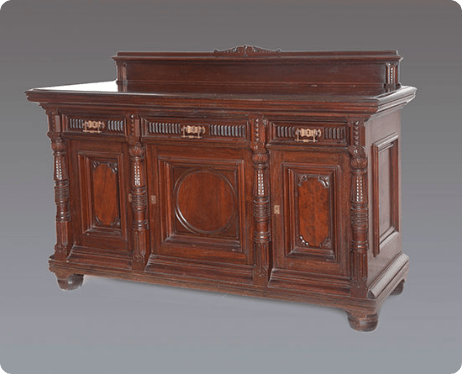
Daniel Pabst, a German-born cabinetmaker, immigrated to the United States in 1849 and became one of Philadelphia’s preeminent furniture makers of the Victorian Era. He produced furniture in several styles, including this sideboard that reflects the fashionable Aesthetic Movement of the last decades of the 1800s, as well as Greek, Renaissance, Gothic, and colonial revivals. Many believe that Pabst also worked with architect Frank Furness (1839–1912) on a number of architectural interiors.
SIDEBOARD
ATTRIBUTED TO DANIEL PABST (1826–1910)
CA. 1870
CHERRY, WALNUT, MAPLE
GIFT OF SEWELL C. BIGGS; 1992.89
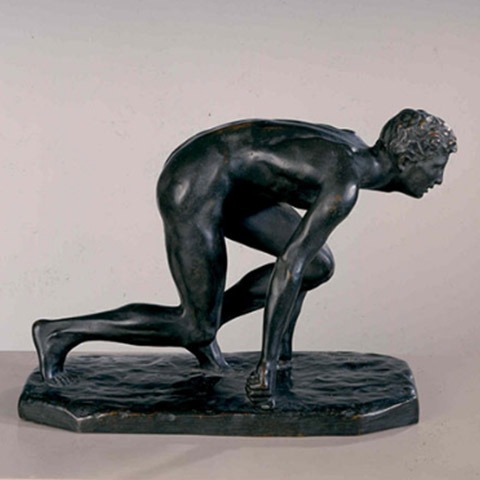
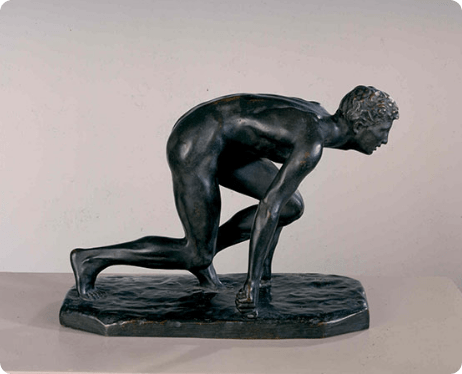
R. Tait McKenzie was educated in both the medical sciences and drawing, and taught anatomy at McGill University in Canada before becoming the director of the physical education department at the University of Pennsylvania. McKenzie taught himself to sculpt, using his medical training to create figure studies of mathematically idealized proportions. He synthesized the proportions of 74 sprinters who could cover 100 yards in 10.4 seconds or less to determine the idealized body measurements of his award-winning Sprinter.
THE SPRINTER
R. TAIT MCKENZIE (1867–1938)
1902
BRONZE
SEWELL C. BIGGS BEQUEST; 2004.492
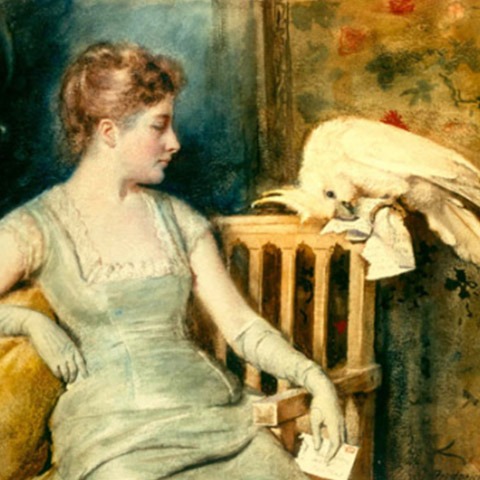
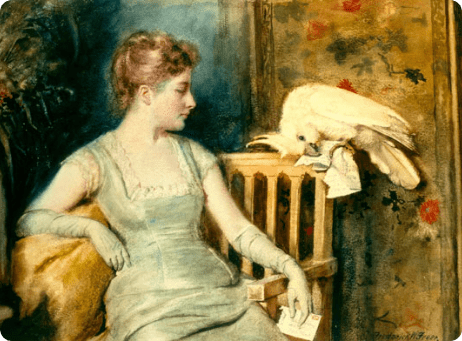
This painting presents an interesting twist on the 19th century troupe of depicting beautiful women engaged in solitary actions. Instead of focusing solely on her beauty and the aesthetics of the scene, Frederick Warren Freer infused a mysterious narrative into the work by including a letter featuring the phrase “do try” and the word “alone.” Freer’s inclusion of a cockatoo, which typically symbolized a wild nature, suggests that there may be more to this prim young lady than meets the eye.
FOR FURTHER THINKING: What do you think was contained in the letter?
THE STOLEN LETTER
FREDERICK WARREN FREER (1849-1908)
1886
OIL ON CANVAS
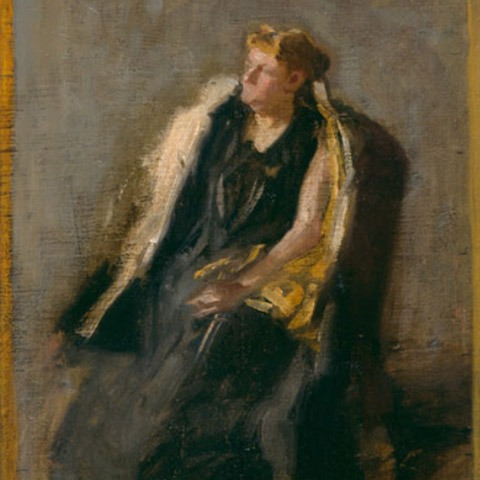
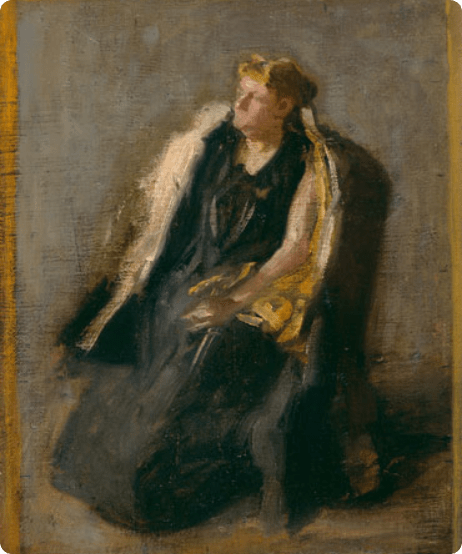
Thomas Eakins was one of the most important American painters of the 19th century. His works are known for their depiction of the sitters’ psychological states, as well as a formal interest in the physiology of the body. This study was mostly likely created in advance of a larger work portraying the same woman, Mrs. Hubbard. Although the study does not possess the artist’s typical attention to personality and physicality, it does offer insight into Eakins’ process and the ways he planned out color choices in his works.
MRS. HUBBARD
THOMAS EAKINS (1844-1916
CA. 1895
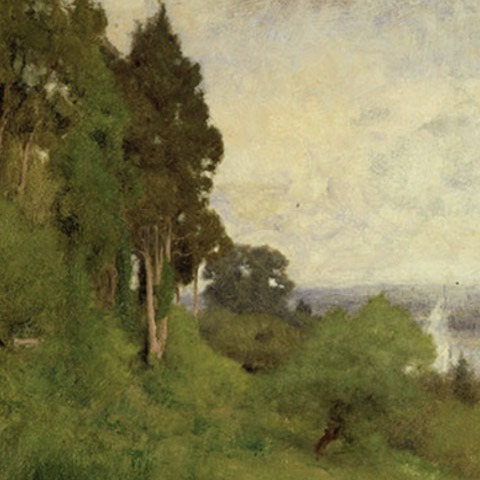
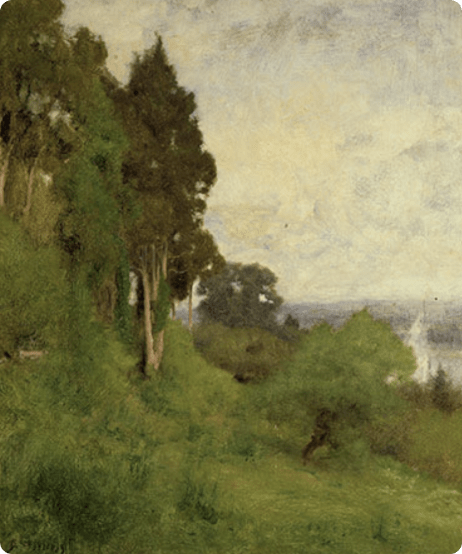
After beginning his artistic training with itinerant painter John Jesse Barker (dates unknown), George Inness worked as a map-engraver during his teen years, studying landscape painting under Régis François Gignoux (1816–1882). In these early years, he also studied at the National Academy of Design, as well as with Hudson River School painters Thomas Cole (1801–1848) and Asher B. Durand (1796–1886). Inness often traveled to Europe, in particular France and Italy, where he practiced painting outdoors, or en plein air.
A GLIMPSE OF THE HUDSON
GEORGE INNESS (1825–1894)
CA. 1880
OIL ON CARDBOARD
SEWELL C. BIGGS BEQUEST; 2004.456
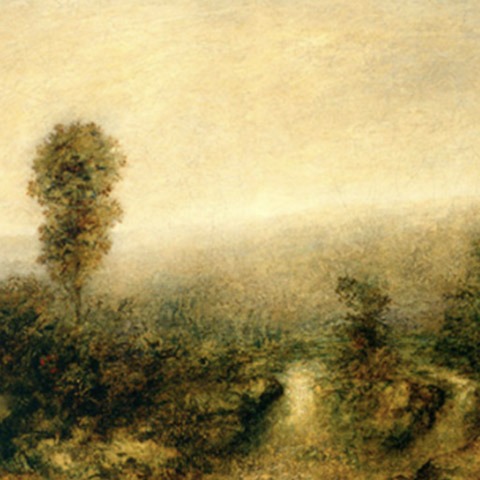
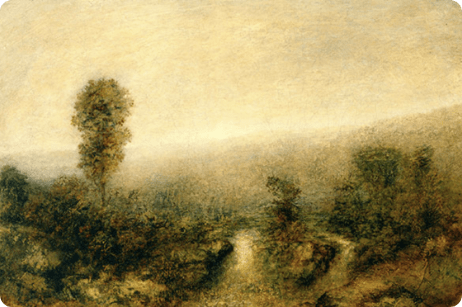
The tonal work of Ralph Blakelock foreshadowed the modern movement in American art, due mostly to its elements of introspection, expressiveness and abstraction. Blakelock had no formal training in painting, and never felt the need to study in Europe, instead touring the American West in 1869. The artist experienced a series of mental breakdowns and entered a mental asylum in 1901, which allowed his release for one day in 1916 to attend a retrospective of his work, including Mountain Stream at Sunrise, at New York’s Reinhardt Galleries.

